In his latest article for the ATM (25.1) journal, SPORTENG Senior Turfgrass Agronomist John Neylan unveil the key traits that make a Turfgrass Agronomist stand out: having an open mind, being inquisitive and having a healthy dose of scepticism!
When John graduated as an agricultural scientist, he remembered often being asked, “So, you’re going to be a farmer then?”. It was difficult for many people to understand that all forms of agricultural production are based on science and scientific research and that agricultural scientists study the many factors affecting the production of the food we eat.
When John started to specialise in turfgrass science, the common theme was, “So, you look after lawns?” The term ‘turfgrass agronomist’ is even more baffling for many, as you explain that agronomy is the scientific study of soil, plants and the environment. Some may suggest that it is a ‘jack of all trades’.
As a turfgrass agronomist, the challenge is having an understanding of all of the elements that affect turf growth and health, including turfgrass species and cultivars, soil physics and soil chemistry, weeds, turfgrass diseases, fertiliser programs etc. Peter McMaugh AM, as a mentor and friend to many of us in the turf industry, describes himself as a problem-solver, and this very much sums up the role of a turfgrass agronomist. The turfgrass agronomist has to have the ability to look beyond the surface symptoms and determine the true cause.
Many years ago, a course superintendent who was under the guidance of another well-known superintendent/consultant was applying fungicides weekly to control an outbreak of Rhizoctonia sp. disease with limited success. The same consultant didn’t believe in renovations, and consequently, the soils were severely compacted; there was poor soil aeration and a lack of viable roots. When the course superintendent took control of the situation and aerated the greens, the disease symptoms quickly disappeared.
As a turfgrass agronomist, this was a great lesson learnt in that we shouldn’t disregard anything when trying to resolve turf problems. We need to stop just treating the symptoms and identify the cause. The fundamentals of soil science, fertility and irrigation will generally apply.
This is a constant theme in the many articles of Peter McMaugh AM around research, observation and education.
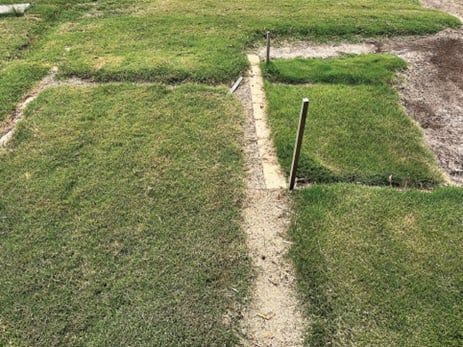 Growing grasses out is an interesting exercise. You get to observe their development, reaction to drought, fertility requirements and recovery after being harvested.
Growing grasses out is an interesting exercise. You get to observe their development, reaction to drought, fertility requirements and recovery after being harvested.
In John's career as a Turfgrass Agronomist, he has been fortunate to be involved in a variety of research projects, particularly during his time at the now-defunct Turf Research and Advisory Institute and at the AGCSA (now ASTMA).
Both provided opportunities to learn a lot about grasses, diseases, water quality, weeds (in particular Poa annua) and the use of diagnostic tools. In undertaking any research, there is always an unexpected result or even a nil result; however, there is always something to be learnt, no matter the outcome. Undertaking research teaches you to be sceptical and to expect the unexpected. One could say that a good turfgrass agronomist needs to have an open mind, be inquisitive and have a healthy dose of scepticism.
For John, one of the most enjoyable parts of being a Turfgrass Agronomist is spending time with turf managers and discussing how they manage their turf. These interactions provide an opportunity to learn, observe and scrutinise and make you realise there are multiple ways of achieving an outcome. It also throws up challenges that require more research.
Since leaving the AGCSA, John has continued his passion for research, and he has been fortunate to undertake projects on behalf of the Victorian Golf Course Superintendents Association and the Sports Turf Association (Victoria). Unfortunately, the turf industry and, in particular, the sports that benefit from the research that is undertaken have failed to support a sustained program of research.
As a turfgrass agronomist, it becomes obvious when there are gaps in the knowledge and that the overseas literature cannot always provide the specific answers required. Just as Peter McMaugh AM has done, John has also undertaken his own research projects to try and fill the many knowledge gaps. That's when John came to realise that you don’t need a sophisticated facility; you just need to have a methodical and well-planned approach to researching the problem. Having a large backyard has certainly helped as well! Over the last few years, John has undertaken a number of projects, many of which have been written up in the ATM journal.
Why use sand for golf greens?
In 2014 it became apparent that golf clubs and superintendents were trying to achieve firmer and fast putting surfaces and finding it difficult to do so using the available USGA-type sands. There was a desire to return to the typical "Melbourne Sandbelt" sand.
The first question was, "What is a typical Sandbelt sand?" and secondly, "Why did we change greens to the USGA-type sands in the first place?"
The desire to change was clearly to do with surface performance and, to some degree, forgetting that many of these native sands had poor drainage characteristics and the surfaces were poor over winter. Consequently, many greens were reconstructed using USGA-type sands to improve winter playability but often proved difficult to manage during the summer months when trying to achieve surface hardness without losing grass in the process.
The research aim was then to test several sands for surface firmness, moisture retention and drainage rate (see photo below).
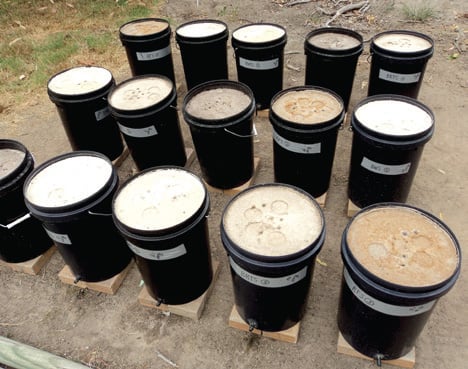 Testing sands for surface firmness, moisture retention and drainage rate.
Testing sands for surface firmness, moisture retention and drainage rate.
The next question was, "What will happen once we grow grass on these sands?"
The research determined several interesting facts:
- The proportions of very fine sand and silt plus clay determine surface hardness.
- There is a fine balance between the proportion of fines and maintaining adequate drainage rates.
- The USGA sands are at their firmest when at field capacity. This finding challenges the typical maintenance regime where minimal water is applied in an effort to maintain a firm surface. In reality, for these sands to be firm, they need to be saturated and then allowed to drain to field capacity.
- USGA sands can go from field capacity to being very dry within 6-12 hours.
- The finer sands have a slower reduction in moisture content which allows the surface to dry out while retaining sufficient moisture to avoid turf stress.
- Establishing a turf surface rapidly reduces the natural surface hardness provided by the sand, and regular sand dusting is critical. Without dusting, the firmness is significantly less within four months of turf establishment due to organic matter accumulation.
- The process of dusting dilutes the organic matter, and the depth of organic matter actually increases. Dusting maintains a very open organic matter matrix.
Rethinking moisture release curves for optimal sports turf surfaces
John has questioned the use of moisture release curves (MRC) to determine the optimum sand depth for sports turf surfaces. The reason behind this is that the field observations of golf greens and sports fields highlight a disparity between the laboratory results and the field observations.
To further explore the relationship between sand type and depth and moisture retention characteristics, a research project was established using large containers constructed as a turf profile. Across the trials, there were several combinations, including sand over gravel, sand over an impermeable base and sand over a modified clay subgrade. All profiles had drainage outlets to allow for the removal of excess water after saturation.
There were two sand types tested – a medium-fine sand and a very fine sand. The sands were tested at 300mm, 250mm, 200mm, 150mm and 100mm depths with three replicates of each treatment. Each container was saturated by a capillary rise to exclude all air bubbles and to ensure complete saturation. Once saturated, the containers were removed from the water and allowed to drain for 24 hours.
It had been previously determined that after 24 hours, the sand would be at equilibrium/field capacity where all of the free water had drained, and there was a balance between air-filled and water-filled pore spaces. At this time, the soil moisture was measured at 50mm depths using a soil moisture probe.
The curves generated demonstrated a similar relationship (shape) to the laboratory-derived curves (see Figure 1 below) though over a considerably shorter range of tension (i.e. 300mm compared to 700mm).
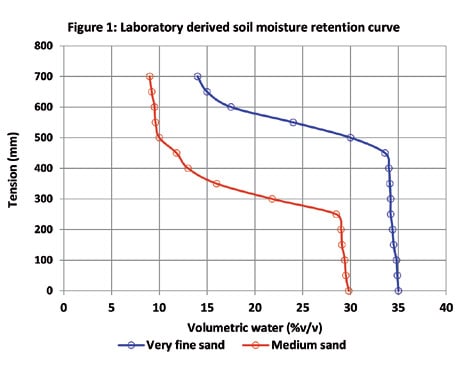 Moisture release curves generated from John Neylan's sands project.
Moisture release curves generated from John Neylan's sands project.
What is most noticeable is that the theoretical air entry point occurred at a lower tension compared to the laboratory test (Figure 2).
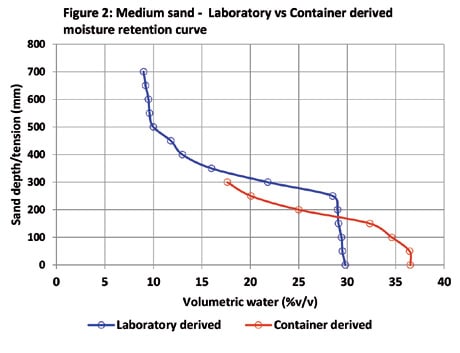 Moisture release curves generated from John Neylan's sands project.
Moisture release curves generated from John Neylan's sands project.
This may, in part, be due to some "suction" from the gravel layer in the container tests.
What it highlights is that the laboratory-derived moisture release curve is only, at best, an indication of the optimum profile depth. A shallower sand layer can potentially be used with a reduced risk of a saturated profile.
Exploring unique grass varieties and their adaptability to harsh conditions
Over the years, John has collected various couchgrasses that have looked interesting and growing in harsh locations or were off-types in more established cultivars and warm-season grasses collected from bentgrass putting greens. It is interesting to observe the development of the grasses, their reaction to drought, fertility requirements and recovery after being harvested.
Some of the most interesting grasses in the field can be absolutely rubbish when they are given a bit of love. At times there seems to be an endless parade of new grasses being marketed, including some that are somewhat foreign to the local growing conditions. John has been particularly interested in the zoysia grasses and how they perform in southern Victorian conditions. The establishment rate from sprigs is slow, though once established, they can be quite vigorous in their upright growth. Some cultivars have extensive rhizome systems (see photo below) and excellent drought tolerance.
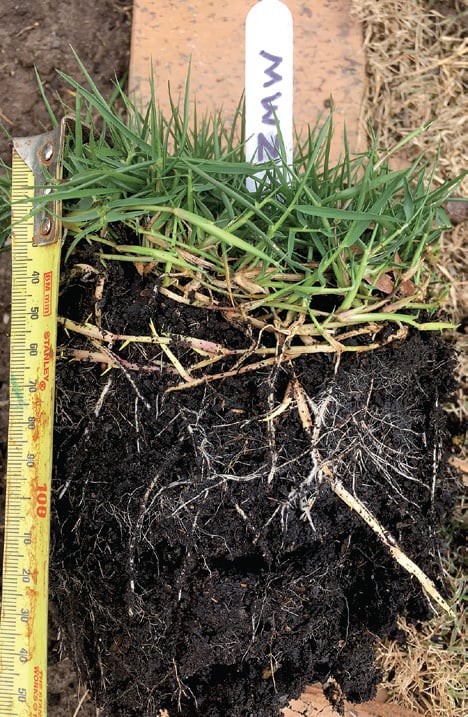 Some Zoysia cultivars have extensive rhizome systems and excellent drought tolerance.
Some Zoysia cultivars have extensive rhizome systems and excellent drought tolerance.
It is noticeable that when growing next to a couch, zoysia can be quickly swamped by the couch due to the vigorous stolon growth. Using native grasses in turf situations has often been attempted with varying results; however, there is still an ambition to include them in out-of-play areas on golf courses. John has collected the seeds of wallaby grass (Austrodanthonia spp., formerly Danthonia) and kangaroo grass (Themeda triandra) and nurtured weeping grass (Microlaena spp.) as a lawn grass. Germinating native grasses has been an interesting exercise with excellent results in establishing wallaby grass, though kangaroo grass has been another story!
Cracking the Code of Poa Annua
In John's many years in the turf industry, understanding Poa Annua has been one of his obsessions. Over the years, he has gone from just trying to kill it to understanding its growth characteristics and the associated seed bank.
Much of the research on the morphology of the plant and the seed bank has been undertaken in the home laboratory, as John has grown hundreds of plants. Growing plants and observing how they behave has provided excellent insight into the complexities of the plant and why it is so difficult to eliminate.
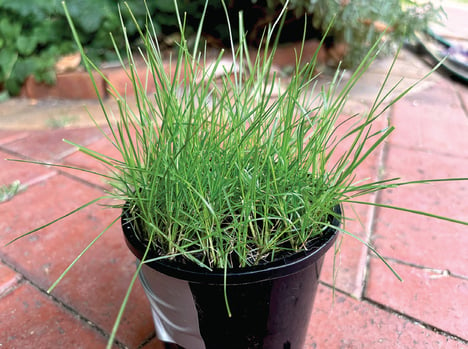 Using native grasses in turf situations has often been attempted with varying results. Germinating native grasses can be an interesting exercise, with excellent results in establishing wallaby grass.
Using native grasses in turf situations has often been attempted with varying results. Germinating native grasses can be an interesting exercise, with excellent results in establishing wallaby grass.
Another research project that he began when Melbourne first went into COVID-19 lockdown was to monitor the lifecycle of Poa Annua in Santa Ana couchgrass. This project has been going on now for a good 30 months and has provided good data related to the stimulus of germination, plant growth and expansion and natural decline.
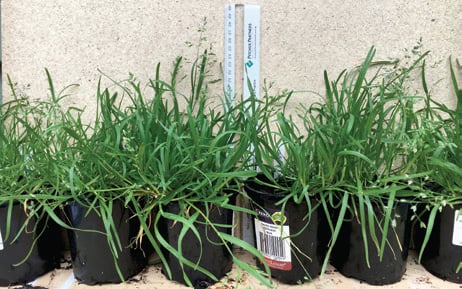 Growing Poa Annua plants and observing how they behave has provided excellent insight into the complexities of the plant and why it is so difficult to eliminate.
Growing Poa Annua plants and observing how they behave has provided excellent insight into the complexities of the plant and why it is so difficult to eliminate.
The following is a general summary of what has been learnt:
- The seed bank is large.
- There is a variation in the pattern of germination depending on the ecotype. That is, some types germinate in one pulse, while others will germinate in several pulses over 42 days. This pattern of germination will influence the effectiveness of pre-emergent herbicides.
- Even on sites where there is strong herbicide resistance, there is still enough variation in the Poa Annua population to provide scope for survival.
- Even in a population of herbicide-tolerant/resistant plants, there was some observable variation in the reaction to the herbicide applications.
- Once plants flower and set seed, they can rapidly establish within the turf sward, particularly if there is adequate soil moisture. Having an adequate pre-emergent program is critical.
- In herbicide trials where half the plant was sprayed with glyphosate, there was strong survival in multi-tillered plants and what appears to be a lack of translaminar movement of herbicide. Applications must provide a high degree of coverage, and follow-up applications are essential.
- The germination of Poa Annua in Santa Ana is strongly related to decreasing temperatures with temperatures less than 22oC. There was no positive correlation to rainfall or soil moisture content, with temperature being the main driver for germination.
Return to the main blog page.

